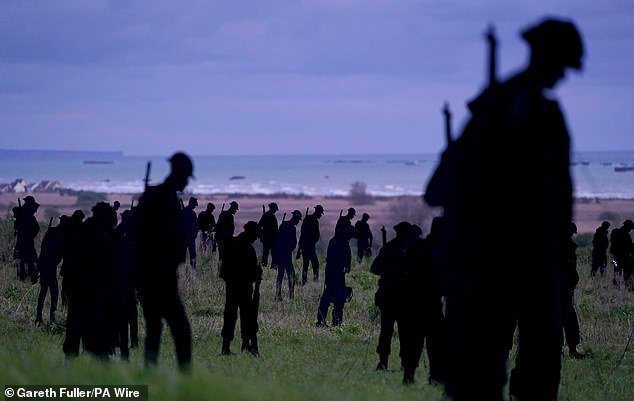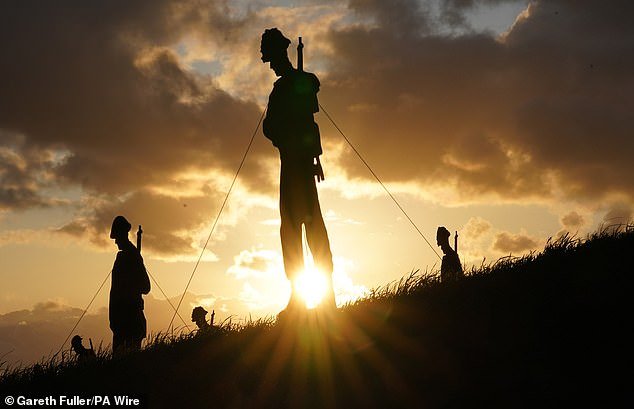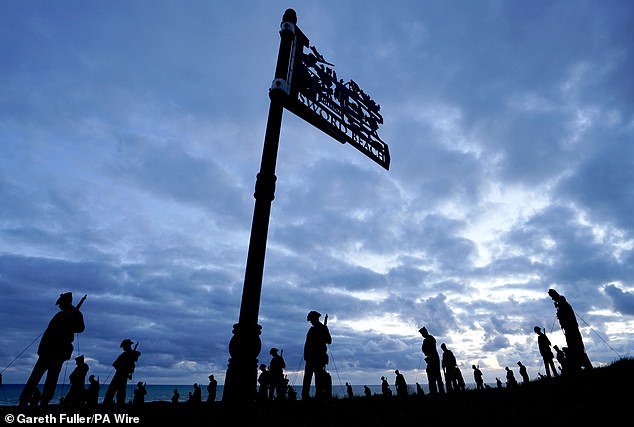Standing in the shadows of giants: 1,475 statues fill the landscape beside D-Day memorial overlooking France’s Gold Beach to honour each of the servicemen who fell during heroic mission
An impressive 1,475 statues have filled the landscape next to a D-Day memorial overlooking France’s Golden Beach, honoring each of the soldiers who died during the historic mission.
The Standing with Giants silhouettes are part of the For Your Tomorrow installation at the British Normandy Memorial in Ver-Sur-Mer, France.
In a stunning nod to the servicemen who died on D-Day almost 80 years ago, the fields on the British Normandy Memorial campus are filled with two-metre-tall statues of soldiers – representing the three military services.
In addition to the 1,475 silhouettes, the project will also install custom-made “giants” to represent the only two women at the Memorial, nurses Sisters Evershed and Field.
The two heroic women died while saving 75 men from a sinking hospital ship.
The Standing with Giants silhouettes are part of the For Your Tomorrow installation at the British Normandy Memorial in Ver-Sur-Mer, France

The staggering number of silhouettes represents the number of fatalities under British command on June 6, 1944
Statues of about fifty French resistance fighters will also be placed around the French Monument.
Images from the project, which launched this spring and will open next summer, show lush green fields dotted with figures casting long shadows across the grass as the sun sets in the distance.
The somber atmosphere reflects the deep emotion and tragedy behind the project, while statues of men with helmets and guns on their backs stand proudly on the French landscape.
The staggering number of silhouettes represents the number of fatalities under British command on June 6, 1944.
According to the British Normandy Memorial website, the instillation will be open to visitors all summer next year.
Standing with Giants is a community project, set up in 2019 by Oxfordshire community artist Dan Barton and a group of local volunteers.
They create large-scale art instillations using recycled building materials and provide meaningful spaces for people to visit, reflect and remember.
Since February, families and organizational groups have been invited to take part in the preparation of the 1,475 statues at a workshop in Oxfordshire, ahead of the instillation in Normandy, which will take place this month.

According to the British Normandy Memorial website, the instillation will be open to visitors all summer next year

The British Normandy Memorial records the names of the 22,442 soldiers under British command who died on D-Day
Those who lost a loved one during the historic mission also have the opportunity to commemorate them with a Tribute plaque next to one of the statues.
The British Normandy Memorial said: ‘Places ordered before May 6, 2024 will be displayed alongside the Standing with Giants installation for summer 2024, allowing ‘your giant’ to stand among his peers.”
The plaques will remain on the site for a minimum of five years.
For £150 people can dedicate a black plaque with a printed white inscription, attached to a 1.2 meter post which will stand in the flower meadow of the British Normandy Memorial in the summer of the 80th anniversary of the D-Day landings .
They are also offered the opportunity to have the silhouette of a soldier, sailor or pilot on their plaque.
The British Normandy Memorial records the names of the 22,442 soldiers under British command who died on D-Day and during the Battle of Normandy in the summer of 1944.
This includes people from more than 30 different countries.
Their names are engraved in stone and have never been brought together until now.
The site also contains a French memorial, dedicated to the memory of French citizens who died during this period.
